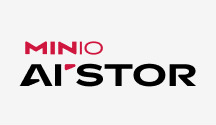
MinIO AIStor


MinIO AIStor
By MinIO
Certified enterprise ready
MinIO AIStor is the standard for building large scale AI data infrastructure. It is a high-performance, software-defined, S3 compatible object store that will run anywhere - from the public cloud to the edge. Enterprises use MinIO to deliver against artificial intelligence, machine learning, analytics, application, backup and archival workloads - all from a single platform.
Runs on
OpenShift 4.6 - 4.15
Delivery method
Operator
Known as the fastest and most highly integrated object storage server on the market. AIStor was built for the cloud operating model it is native to the technologies and architectures that define the cloud. Enterprise features include inline erasure coding, bit-rot detection, state-of-the-art encryption, active-active replication, object locking, lifecycle management, observability, key-management, caching, firewall/load balancing, global console, search and identity + access management.
Performance
With its focus on high performance, MinIO enables enterprises to support multiple use cases with the same platform. For example, MinIO’s performance characteristics mean that you can run multiple Spark, Presto, and Hive queries, or to quickly test, train and deploy AI algorithms, without suffering a storage bottleneck. MinIO object storage is used as the primary storage for cloud native applications that require higher throughput and lower latency than traditional object storage can provide.
Kubernetes Native
MinIO was born into the cloud. Containerization and orchestration is our customer base’s default implementation. Our focus on the cloud native way has resulted in an exceptionally clean Kubernetes implementation. As a result, MinIO can be found on every Kubernetes distribution from the public cloud to the private cloud.
Scalability
MinIO employs the same techniques as the hyper-scalers using simplicity as a building block. By consuming resources in small, discrete chunks, MinIO customers additional instances and can pack them densely - up to exabyte scale. Cloud-native applications start small at the prototyping phase, but often grow to multiple racks and sometimes to multiple data centers spread across geographies. MinIO is designed to scale seamlessly alongside the application’s demands.
Multi-tenancy
MinIO is designed for the multi-tenancy world of Kubernetes. With MinIO, tenants are fully isolated from each other with their own instances of MinIO clusters. Each tenant in turn may have multiple users with varying levels of access privileges. Each tenant cluster operates independently of each other and due to the size of the MinIO binary (<100MB) can be densely packed for efficiency. Standard HTTP load balancers or round-robin DNS may be employed.
Security
MinIO encrypts data when stored on disk and when transmitted over the network. MinIO’s state-of-the-art encryption schemes support granular object-level encryption using modern, industry-standard encryption algorithms, such as AES-256-GCM, ChaCha20-Poly1305, and AES-CBC. MinIO is fully compatible with S3 encryption semantics, and also extends S3 by including support for non-AWS key management services such as Hashicorp Vault, Gemalto KeySecure, and Google Secrets Manager.
PromptObject API
The promptObject API is a powerful new extension of the S3 API that lets users or applications talk to unstructured objects as if they were talking to an LLM - with zero domain knowledge required. That means you can ask an object to describe itself, to find similarities with other objects, to find differences with other objects.
AIHub
AIStor AIHub is a private repository for storing AI models and datasets directly in AIStor. It is API compatible with Hugging Face, enabling enterprises to create their own data and model repositories on the private cloud or in air-gapped environments without changing a single line of code. This eliminates the risk of developers leaking sensitive data sets or models.
RDMA
Remote Direct Memory Access (RDMA) allows data to be moved directly between the memory of two systems, bypassing the CPU, operating system, and TCP/IP stack. This direct memory access reduces the overhead and delays associated with CPU and OS handling of data, making RDMA particularly valuable for low-latency, high-throughput networking.
Additional resources
Want more product information? Explore detailed information about using this product and where to find additional help.
DOCUMENTATION
How To Deploy a MinIO Tenant
Procedures for using the MinIO Operator Console or oc minio plugin to deploy a MinIO Tenant.
DOCUMENTATION
Core Concepts
Start here to learn about core concepts such as erasure coding and bucket versioning.
DOCUMENTATION
Manage a MinIO Tenant
Procedures for managing existing MinIO tenants on OpenShift.
DOCUMENTATION
Configure Tenant Security
Learn about MinIO IAM in context of MinIO Tenants on OpenShift.
DOCUMENTATION
Production Considerations
Considerations for deploying production-grade MinIO Tenants on OpenShift infrastructure.
DOCUMENTATION
MinIO Client Complete Guide
MinIO Client (mc) provides a modern alternative to UNIX commands like ls, cat, cp, mirror, diff etc.
DOCUMENTATION
MinIO Admin Complete Guide
MinIO Client (mc) provides admin sub-command to perform administrative tasks on MinIO deployments.
DOCUMENTATION
Best Practices for MinIO on Red Hat OpenShift
Top 3 reasons to run MinIO on OpenShift and best practices for managing storage class and tiering, load balancing, encryption keys, certificates, logging, monitoring and alerting across an OpenShift hybrid cloud.
COMPANY INFORMATION
MinIO
Visit the homepage of the provider.